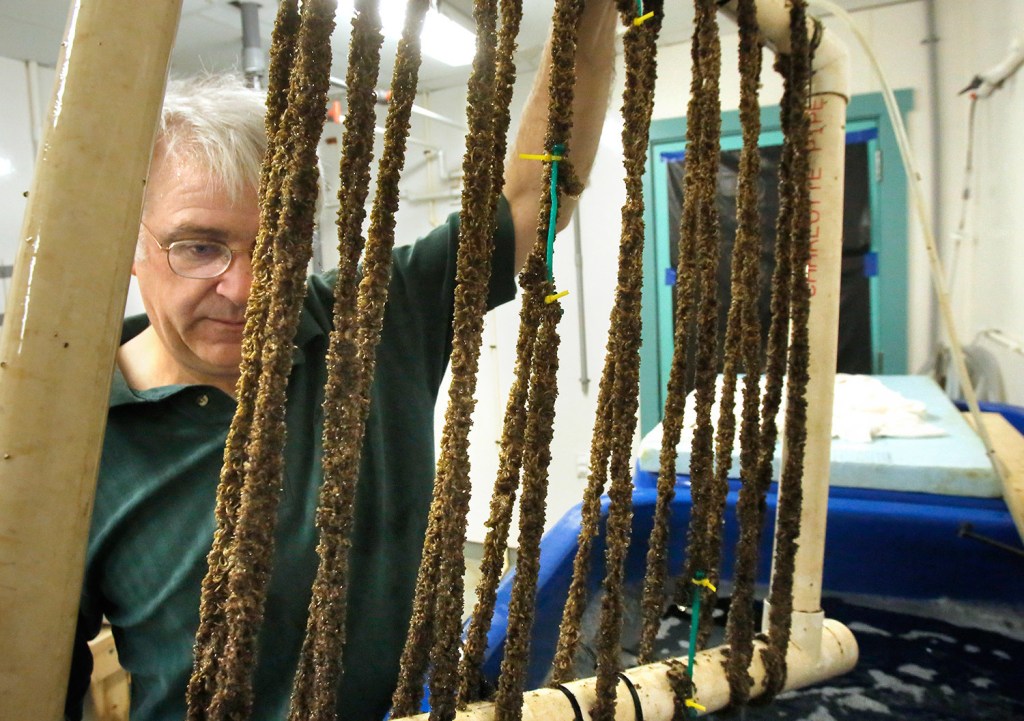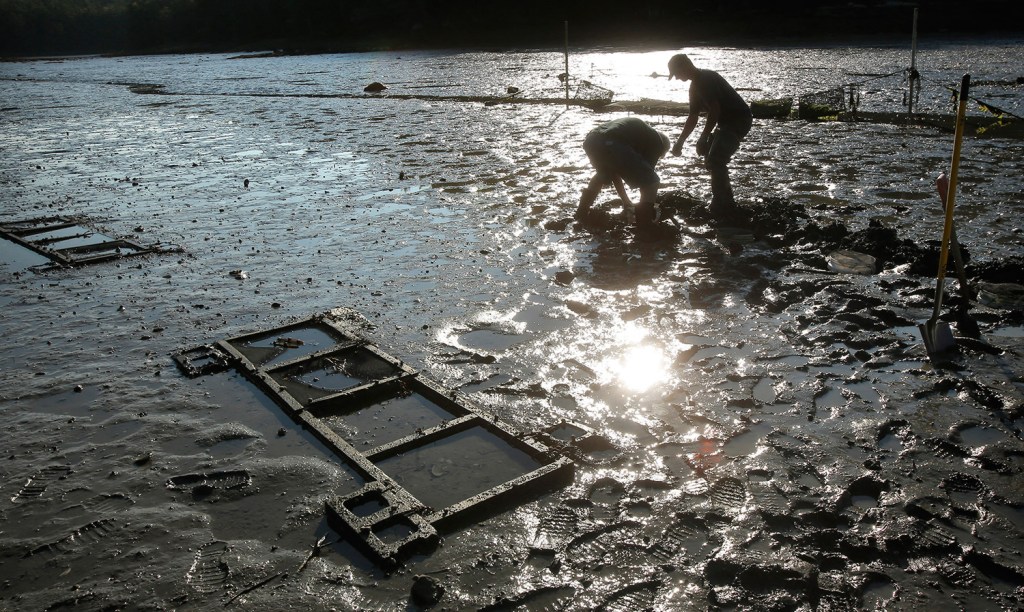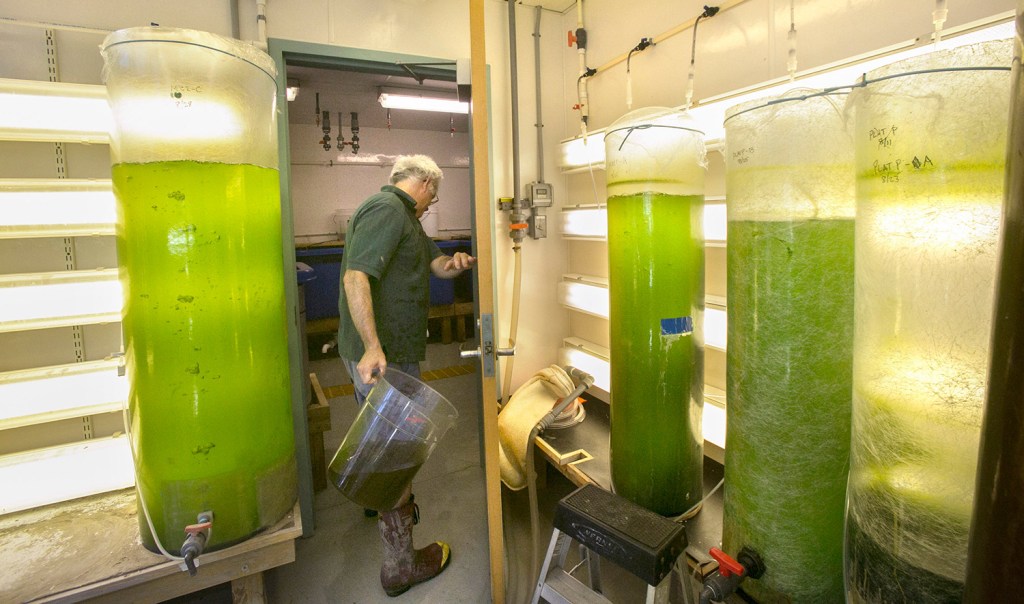I
n seawater tanks in a refrigerated room at the Darling Marine Center, the baby mussels are thriving.
Two months ago they were near-invisible larvae, swimming around in the tanks. Now tens of thousands of the tiny mollusks, each just a few millimeters long, have attached themselves to the different kinds of rope scientists have been testing here, and are eating the lab’s stock of algal food at an impressive clip.
Mick Devin, the lab manager at this University of Maine marine research facility, has been overseeing this experiment, part of an effort to master the art of hatching mussels, something mussel farmers – who grow their product on lines hanging in seawater – have never previously needed to do.
“Mussel farmers have been able to just throw their lines out and collect all the larvae they want from nature,” Devin says. “But mussel populations are down drastically in this state, so that may not be working so well now.” Hatcheries, he expects, may have to step up in the not-too-distant future.
Mussels have been vanishing from stretches of coastline where they once were ubiquitous, and scientists remain uncertain as to why. Green crabs, whose population exploded after an “ocean heat wave” in 2012, may have stripped many sections clean. But warmer water and increased rainfall – both problems expected to grow in Maine as a result of global climate change – may be creating a far worse problem: an acid sea.
“We know this affects larval development in bivalves, (and) chances are it will result in decreased numbers, whether it’s a natural population on a bed or one in a farm,” says Paul Rawson of the University of Maine’s School of Marine Sciences, who is in charge of the research. “We need to make sure the technology is in place so the farms will have a reliable source of seed.”

T
he world’s oceans are turning more acidic. Since the Industrial Revolution, carbon dioxide levels in the atmosphere have grown by more than 70 percent and now stand at the highest level in at least 800,000 years. As the oceans absorb additional CO2, they’ve become 30 percent more acidic over this period. By 2050, scientists estimate surface pH levels will be lower – that is, more acidic – than at any time in several million years and by 2100 more acidic than any time in the past 300 million years – two or three times more so than today.
The Gulf of Maine is particularly vulnerable because its colder water more readily absorbs carbon dioxide and because the increasing frequency of major snow and rain events flood the gulf with more acidic river runoff. Monitoring buoys have recorded an increase in CO2 levels of about 1.25 parts per million – or roughly 0.3 percent – per year in the gulf since they were installed in 2007.
With climate models predicting a 10 percent to 14 percent increase in winter precipitation across Maine, New Hampshire and most of eastern Massachusetts – and more modest increases in spring and fall – the situation is expected to continue worsening faster than the global average, with serious effects on marine life and coastal communities.
“Maine is ground zero for North Atlantic acidification,” says Mark Green, professor of marine science at Saint Joseph’s College in Standish. “It’s happening, it’s documented, but we don’t know when the tipping point is going to be reached.”
Maine’s fisheries economy is also especially vulnerable, as it depends on species that may not thrive in a more acidic gulf. “Shellbuilders are the ones that will be impacted the most and we have an overwhelming reliance on shellbuilding organisms,” notes Susie Arnold, a marine scientist at the Island Institute in Rockland who studies the problem. Eighty-seven percent of the value of Maine’s commercial fish catch comes from creatures that have shells, including lobsters, clams, scallops and oysters.
The effects of acidification on lobsters have barely been studied in colder water. The only published research – a 2012 study from Saint Francis Xavier University conducted on Nova Scotia’s northern coast – suggested that larvae exposed to acidic conditions were smaller and slower to develop, though scientists say more research is needed to really get a handle on the effect.

M
ost immediately affected are bivalves such as mussels, oysters and clams, which have a much harder time building their shells in more acidic conditions.
Bill Mook, owner of Mook Sea Farm just up the river from the Darling Center, started seeing mass die-offs of oyster larvae at his hatchery a decade ago, usually following a major storm, an increasingly frequent occurrence in Maine. “We’d see the swimming larvae develop normally for a week or two, and then they’d just stop feeding,” he recalls. “At first we couldn’t figure out what was happening.”
Then in 2009 a visiting Oregon oyster farm owner described an ongoing disaster in that state’s hatcheries, where production had fallen by 80 percent. The larvae, he told colleagues in Maine, turned out to be dying because the water was too acidic, making it much harder for them to build their first shells out of dissolved calcium carbonate in the surrounding seawater. The energy reserves from their eggs was running out before the larvae could develop their digestive organs and survive on their own.
Mook began testing the pH of the water entering the hatchery from the Damariscotta: After each storm it was way too high, and the level in between storms was going up as well. “When I started my business 30 years ago, the CO2 levels were at least 30 parts per million lower, so even during spring rains the carbonate conditions would remain OK,” he says.
Now, with the background level higher, each major storm drove acidity conditions into the red. In a few decades, even the background level may be too high for spring larvae to survive.
Mook now treats the water coming into his hatchery to ensure proper pH levels are maintained, but he fears what it means for wild shellfish populations. “The real question here is what is happening to the mussel larvae,” he says. “I predict the impact of ocean acidification is going to be first felt by the wild bivalve fisheries like clams and mussels and will be manifested by a failure of recruitment” – the failure of the infants to survive and become adults.

T
he state’s aquaculture industry is extremely concerned about acidification. “Make no mistake about it: What is at risk here is nothing short of the future of the aquaculture and fishing sectors of this state,” Maine Aquaculture Association executive director Sebastian Belle warned state legislators in June.
Belle says he knows of at least one instance where mussel farmers witnessed a different sort of failure: The larvae built their shells and grew into tiny mussels but couldn’t attach themselves to ropes for some reason. This is particularly worrisome, because scientists at the University of Washington have found that acidification substantially reduces the strength of the thread-like material – the byssus – that mussels use to anchor themselves.
“We don’t know enough about the physiological impacts of shifts of ocean pH on specific organisms,” Belle says. “There’s been a lot of talk about shellfish, but we’ve heard relatively little about the impact on larval finfish. What about cod and halibut larvae?”, two species farmed in Maine. “Is there an impact on their ability to metamorphose and grow into juveniles?”
Researchers at Stony Brook University in New York have also established that high carbon dioxide levels in seawater kill many hard-shell clam larvae and weaken the shells of the juveniles that do survive, stunting their future growth even when CO2 levels returned to normal.
Jeff Clements, a doctoral student at the University of New Brunswick in Saint John, has been studying how juvenile soft-shell clams deal with another problem: muddy bottoms that have become more acidic. “If they are exposed to acidic sediments, they won’t burrow into them,” he says. “The juveniles let the tidal currents carry them around as they search for places where that’s not a problem. Problem is, they’re exposed to predators the whole time they do that.”
With all of these challenges, Green of Saint Joseph’s College thinks humans are going to have to learn to grow shellfish larvae into juveniles to maintain wild stocks. “Hatcheries are going to become so important, because wild populations are going to falter,” he says. “Larval clams and mussels can’t survive with the water chemistry changes that are going to come. There’s no two ways about it.”
Colin Woodard can be contacted at 791-6317 or at: cwoodard@pressherald.com
Twitter: WoodardColin
Part 1: Big changes are occurring in one of the fastest-warming spots on Earth
Part 2: As Gulf of Maine warms, puffins recast as canaries in a coal mine
Part 3: Gulf of Maine’s cold-craving marine species retreat to deeper waters
Part 4: Invasive species exploit a warming Gulf of Maine, sometimes with destructive results
Friday: What is Maine doing to protect the gulf from climate change? So far, not enough.
Send questions/comments to the editors.





Comments are no longer available on this story